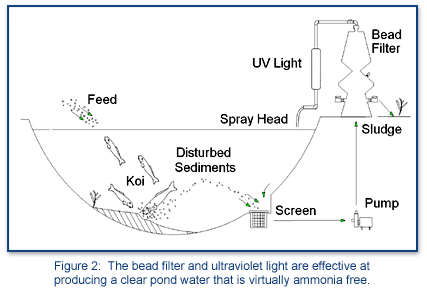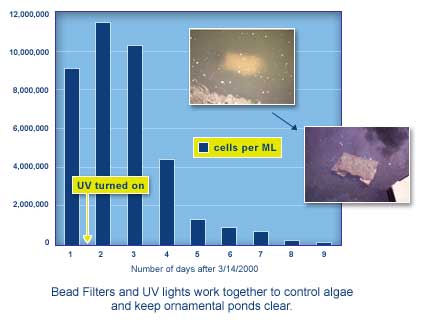|
|
 Natural ponds are driven by the growth of algae and plants.
The photosynthetic processes limit the amount of waste products
that the system can generate and the pond is generally able
to assimilate these wastes without endangering the fish. Feeding
a pond disrupts these balances. A number of identifiable processes
must be undertaken to restore the pond to a pristine condition.
The need for more oxygen dictates that the water be circulated
with a pump and is usually cascaded down the face of a waterfall
to aesthetically address the need for aeration. Clarification,
or solids removal, is usually undertaken as the first water
reconditioning step. This is a very critical operation since
solids settling to the bottom of a pond tend to decay consuming
a lot of oxygen and produce harmful waste products such as ammonia.
Clarifiers however do little to address dissolved chemical wastes
(organic material, ammonia, nitrite) that are found in the pond.
These dissolved wastes are generally addressed by a biofiltration
device that houses beneficial bacteria that remove the wastes.
Finally, ponds that are in the direct sunlight must have an
algae control strategy otherwise the algae will reproduce so
quickly that they will cloud the water.
Natural ponds are driven by the growth of algae and plants.
The photosynthetic processes limit the amount of waste products
that the system can generate and the pond is generally able
to assimilate these wastes without endangering the fish. Feeding
a pond disrupts these balances. A number of identifiable processes
must be undertaken to restore the pond to a pristine condition.
The need for more oxygen dictates that the water be circulated
with a pump and is usually cascaded down the face of a waterfall
to aesthetically address the need for aeration. Clarification,
or solids removal, is usually undertaken as the first water
reconditioning step. This is a very critical operation since
solids settling to the bottom of a pond tend to decay consuming
a lot of oxygen and produce harmful waste products such as ammonia.
Clarifiers however do little to address dissolved chemical wastes
(organic material, ammonia, nitrite) that are found in the pond.
These dissolved wastes are generally addressed by a biofiltration
device that houses beneficial bacteria that remove the wastes.
Finally, ponds that are in the direct sunlight must have an
algae control strategy otherwise the algae will reproduce so
quickly that they will cloud the water.

This bead filter configuration takes advantage of the fishes’
tendency to root through the bottom sediments as they search
for food. A slotted pipe or screen box is placed twelve inches
above the bottom of the pond. Positioned above the bottom
the intake screen will not tend to accumulate leaves and will
still rapidly capture any solids suspended by the fish. The
water is moved from the inlet screen to the bead filter by
a low head water pump. The water pump should be selected to
deliver a high rate of flow at a low pressure to avoid high
energy costs. The bead filter concurrently acts as a clarifier
removing solids and as a biofilter. The bacteria growing on
the beads in the filter are particularly effective at removing
ammonia from the pond water. The filtered water is then passed
through a ultraviolet light that specially designed to kill
bacteria and algae. This configuration has a high water reconditioning
capacity . It will allow you to maintain pristine water conditions
even as you dramatically increase the size and number of koi
or goldfish in the pond. But, remember that the life support
systems for your fish are dependent on the pump. If you lose
electrical power then a heavily populated pond will rapidly
run out of oxygen. So, unless you are willing to provide a
battery operated backup air pump you should limit your fish
density.
Design guidelines for Beadfilter/UV light combinations were
generated in the mid-1990’s. The guidelines show the relationship
between filter, ultraviolet light size and pond size. The
recirculating flow rate is specified to assure that the algae
are rapidly and repeatedly exposed to the UV light.. This
flow also assures enough oxygen is supplied to keep the bead
bed aerobic. A pump capable of delivering the indicated flow
at a head pressure of about 20 feet should be selected. The
carrying capacity of this filtration combination is high enough
to accommodate a large number of fish. These guidelines have
been used in thousands of ponds and proven so reliable that
many distributors have developed more liberal tables for their
local conditions. These guidelines are not as conservative,
but generally seem to work very well and may save money.

Microscopic algae will grow in amazing numbers in the typical
koi pond. Only about 5 microns in diameter the most troublesome
algae grow suspended in the water column The conditions for
the growth are so good that they can double their population
in less than 12 hours. The critical nutrients phosphorus and
nitrogen are found in excess levels, a by-product of the wastes
excreted by the fish. In the pond illustrated above the algae
density often exceeded 5 million algal cells per ml of water.
These high numbers cause the water to be green and cloudy
. Although these high algae concentrations generally have
no direct adverse effect on the fish, they seriously impair
the aesthetics of the pond and can make viewing of the fish
impossible. In the experiment illustrated above, the installation
of the ultraviolet light resulted in the rapid elimination
of the algal population and, as the pictures illustrate, the
pond rapidly cleared up. This experiment has been repeated
many times. It generally takes a ultraviolet light about a
week to complete transition from green water to clear. Ponds
in the shade of a tree may not need a ultraviolet light, but,
most do if the periodic greening of the water is to be avoided.
The ultraviolet light must be properly sized (10-20 watts
per thousand gallons) and all the pond water should be recirculated
through the light about every 3 hours to assure a complete
kill.

Bead filters use a small plastic bead about 1/8 inch in diameter
as a filtration media. These beads are floated to the top
of the filtration hull where they form a packed bed. The dirty
water is passed upward through the bed where it is cleaned.
Suspended solids are physically removed from the water by
the bead matrix. A bacterial film coats each bead. There are
about 60,000 beads in a cubic foot of beads. So there is plenty
of surface area to support the bacterial population. Most
of the bacteria in the filter extract organic matter (BOD)
from the water. A smaller population of slow growing nitrifying
bacteria extract the toxic ammonia from the water. Bead filters
are often called bioclarifiers because of their ability to
concurrently act as both a solids clarifier and a biofilter.
The beads are never replaced, but, the bed is cleaned every
few days to prevent headloss buildup.
The propeller-washed system is available in sizes from 3 to
100 hundred cubic foot. The largest ones built were 450 cubic
foot. These are commercial quality filters with 20-30 year
design lives. In a propeller–washed filter the system is cleaned
by turning off the pump, mixing up the beads with the propeller,
then settling for about 5 minutes. During the settling period
the bead float and the sludge sinks. A thick sludge is then
removed before the pump is started. Propeller–washed filters
are normally used on larger koi ponds.
Bubble-washed filters are available in sizes ranging from
¼ to 10 cubic foot. They are cleaned by bubbles sucked in
as the hull is drained. These units are widely used in koi
ponds and experimental fish systems. They are simple systems
with no moving or metal parts. |
|
 |
|





